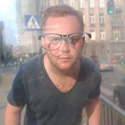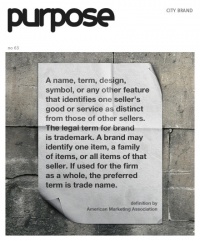
Feature
Unique identity

Igor Gałązkiewicz
Art historian dedicated to scientific issues of architecture, design and marketing. He does research on the role of architecture in the process of creating and refreshing a brand. He also deals with consulting in culture as a tool in branding activities. Conducted presetnations for The Great Theater - nAtional Opera and Inteligo PKO Polish Bank and others.
In free moments he discovers a complex of a Czech kubizm architecture form and spends time in caffeterias.
For the past few years we have been observing the increase activity level of local authorities who encourage us (using every form of advertising from outdoor to social media) to fall in love with the city (Warsaw), be inspired by the city (Lublin), or more prosaically – to meet in the city (Wroclaw).
The awareness of place branding (or place marketing) role in creating promotion and communication strategy has been successively growing within the space of the last decade. By creating the brand place through the instruments similar to creating the market brand there should be assumed that the city is a complex creation with multi-layered structure but popular and permanent message builds one or two strong symbols at the most that are the core of the campaign. Some extra strands may orbiting around the core that allowing for better communication with estimated target groups.It is hard to imagine successful and permanent campaign in case of place branding actions based on ephemeral activities where long-term action plan has not been included. Brand building concerns identity building above all what is particularly essential in the context of Polish cities of which they have been deprived on numerous occasions or attempts have been made to top-down implement its character.
Finding own unique identity – both forgotten and formulated anew is one of the basic purposes of priority significance as the identification or elaborate campaign using even most innovative marketing tools will lose its superior value without it – building the identity of a place.
It is worth to examine the promotional strategy of Polish cities from the angle of branding strategy of Poland. Although the core idea of Wally Olins entitled Creative Tension perfectly renders the spirit of our country, it is difficult to find concrete actions related to it. Naturally, the branding process is calculated for long-standing time perspective. However, there arises a question how vigorously it is going to be realized. The fact that Poland has been put in the 82nd place in the report of The FutureBrand 2010 Country Index that collaborates with consultancy firm FutureBrand with BBC World News station is probably not instilling optimism. Such criteria as tourism, legacy, culture, business-friendly conditions and life quality were taken into consideration while creating the index. The position of Poland in this report makes us aware of how much still needs to be done when it comes to promoting the country and popularizing its cities.
Branding of Polish cities is currently on the early stage of its development. Noticeable changes are of superficial character, however one may observe that the city brand is starting to be perceived as a living organism and its normal functioning depends of proper stimulation. Only consistent strategy implementation will allow to constitute in the receiver’s awareness a complex structure the brand place is.
It is important to perceive wider the branding process – as identity creating, building up the idea, not on a short-term but realized and calculated as a long-standing investment. It is not easy to determine whether Polish cities will handle the long-term realization of challenges associated with the branding process but we can certainly claim the process is taking on dynamically.
Branding activities should start from building relations with surrounding, that is inhabitants. Diversification of the business, cultural and social offer should be the goal of those activities what would result in creating the identity more effectively and winning desired target group over.
Observed qualitative changes that has taken place in many cities of Poland make us believe that the role of place branding is going to be the catalyst for changes not only in communication of city with the world but with its residents in the first place. Even best thought-out strategy will not replace the joy of life of inhabitants (present, as well as future ones) and guests. Still, it is difficult to conjure reality, incessantly repeating slogans about Friendly Cities, Cities of Future or Inspiration if such functions are not performed.
Polish cities discover its potential what is proved by interesting actions of Lublin, Warsaw, Wroclaw, Danzig or Bialystok. In Lublin, worth noticing is the conception of the clash of modernity with tradition and the use of frescos from The Chapel of The Holy Trinity located in the Lublin Castle. Important is that they were the core of the 2008 campaign and were presented contextually in each of the variants.
In turn, with reference to Warsaw there should be mentioned a number of initiatives unrelated to The City Hall’s activities (“Fall in love with Warsaw” campaign is directed rather inwards and its function is to thaw the image of the capital city in eyes of Poles) that have a considerable influence on its perception. Particularly interesting are activities that have been carried out to implement by a number of capital cafes that hold cultural events that serve as a characteristic cultural forum of the city, as well as the activities of all associations, i.e. foundation Uptown publishing the new magazine “WAW” but also responsible for the Internet guide to interesting places Wrsw.pl. All the initiatives have the influence both on the city’s perception by residents themselves and strangers and life quality what is one of the most important elements that strengthen the place branding.
Warsaw wants to set the tone in this part of Europe and realizes that how essential is culture in the process of creating the image, that is why the activity in inviting entries for cultural institutions is becoming more noticeable nowadays. Over the last few years victorious projects for The Museum of Modern Art, Polish History Museum, Museum of the Polish Army, Museum of the History of Polish Jews (ongoing project) or the seat of Sinfonia Varsovia have been selected. Important factor that influences the image of a concrete urban centre is to perceive it through the brands that locate its office in there. Significant global brands can form the city image very well and add luster through the synergy of values that are carried with it. In fact, promoting the potential and creating a message through strong brands headquartered in the city is the idea of Poznan that presents itself as know-how city that stands for a great place for conducting business. In one of commercials, the images of most popular brands headquartered in the capital of Great Poland have been used. Therefore, one may notice that know-how of Poznan is a strategy that has been consistently implemented for years and its best safeguard are the brands mentioned in commercials (Allegro, Volkswagen, W. Kruk or Nivea). What is more, corporate identity carries also such values as innovations, business potential, intellectual or cultural base. Consequent use of this identity is also worth emphasizing (it also appeared at the Lech Poznan Stadium). The advertising agency Just (rewarded for the creation of “Poznan – the city of know-how” in Zlote Orly competition in 2009) suggested fresh identity using the asterisk that function as a reference to other, broader sources of knowledge. Thanks to the consistency of promotional campaign of Poznan, its most essential attributes and potential are getting more and more visible.
However, even the best identity and communication will not replace the consistency in implementing the strategy and following real actions. Perfectly edited commercial depicting most attractive spots in the city may turn out to be a perfect trailer of a weak movie at a closer look [sic!]. Nevertheless, the quality of commercials of the campaign conducted since 2007 is relatively high and a special recognition deserves recently broadcasted (among others in CNN) short spot of Xawery Żuławski (the author of the film adaptation “Wojna Polsko-Ruska” of Dorota Maslowska’s prose) depicting Grand Poland’s capital from the bird’s eye view. The spot is dynamic and illustrates the strategy assumptions.
The city of Poznan attempts to promote to Polish capital of innovation and over the years a lot have been done to let Poles know about it. We could have noticed a lot of billboards presenting the new identity of Poznan in many native towns. The range of well-matched media was wide – the campaign appeared in press, as well as in electronic media and outdoor carriers. Ambient actions were also used. In the campaign’s assumptions, teaser phase presenting mentioned headquartered brands was also taken into consideration, but only the asterisk was demonstrated instead of full logo.
Non-standard and innovative in the context of Polish image activities is also mobile installation used by Poznan in promoting the city in Europe. The futurist capsule designed by architects of MOA (Master Of Arts) gives a chance to relax inside and watch movies about Poznan, but most of all, its main function is to promote the capital of Great Poland as a city open to new technologies and sensitive to good design. The capsule provided with the logo of Poznan has been promoted among others in Italy, Germany or Belgium under the slogan “Poznan. Eastern energy. Western style”.
It seems like the biggest changes the future is going to bring and the battle for the title of The European Capital of Culture 2016 will be the factor which stimulates the development of place marketing. The proper measure of understanding the essence of place branding by Polish local authorities turn out to be not spectacular image campaigns but its systematic implementation not only in the main urban institutions but also in provincial ones.
Text: Igor Gałązkiewicz
Translation: Anna Kozłowska
Check the archive

no 63 February 2012
theme of the issue:
CITY BRAND
< spis treści
Article
From editors
Presentation
Montreal – creativity, originality and diversity
Career in Culture
Creativity centre - interview with Muhd Hanafiah - Agnieszka Furmańczyk
Culture Industries
Strong brand "phenomenon" - Paul Alezraa
Feature
Unique identity - Igor Gałązkiewicz
On the Margin
Creative Szczecin, renewed - Marcin Niewęgłowski





